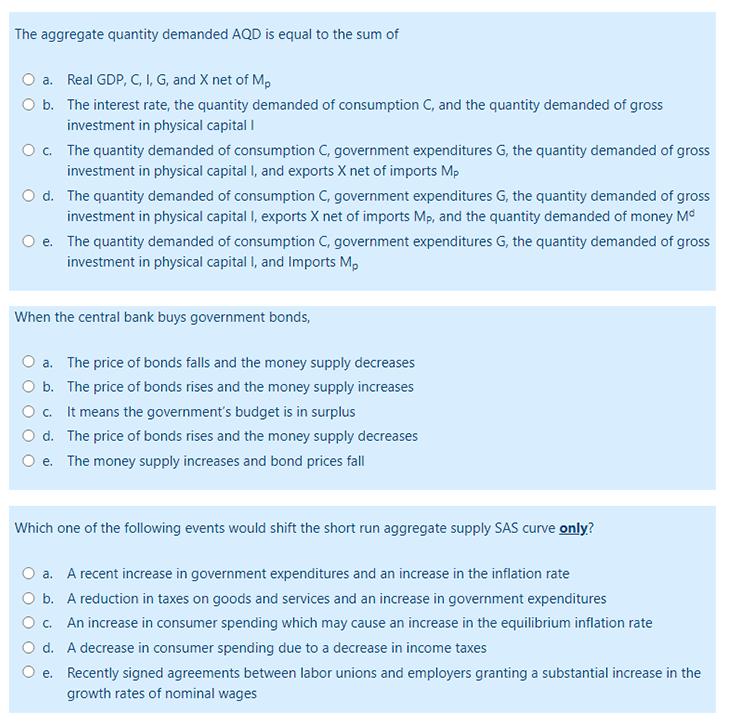The aggregate quantity demanded AQD is equal to the sum of a. Real GDP, C, I,...
Fantastic news! We've Found the answer you've been seeking!
Question:

Transcribed Image Text:
The aggregate quantity demanded AQD is equal to the sum of a. Real GDP, C, I, G, and X net of Mp b. The interest rate, the quantity demanded of consumption C, and the quantity demanded of gross investment in physical capital I O c. The quantity demanded of consumption C, government expenditures G, the quantity demanded of gross investment in physical capital I, and exports X net of imports Mp d. The quantity demanded of consumption C, government expenditures G, the quantity demanded of gross investment in physical capital I, exports X net of imports Mp, and the quantity demanded of money Mc e. The quantity demanded of consumption C, government expenditures G, the quantity demanded of gross investment in physical capital I, and Imports Mp When the central bank buys government bonds, a. The price of bonds falls and the money supply decreases b. The price of bonds rises and the money supply increases c. It means the government's budget is in surplus d. The price of bonds rises and the money supply decreases e. The money supply increases and bond prices fall Which one of the following events would shift the short run aggregate supply SAS curve only? a. A recent increase in government expenditures and an increase in the inflation rate b. A reduction in taxes on goods and services and an increase in government expenditures c. An increase in consumer spending which may cause an increase in the equilibrium inflation rate d. A decrease in consumer spending due to a decrease in income taxes e. Recently signed agreements between labor unions and employers granting a substantial increase in the growth rates of nominal wages The aggregate quantity demanded AQD is equal to the sum of a. Real GDP, C, I, G, and X net of Mp b. The interest rate, the quantity demanded of consumption C, and the quantity demanded of gross investment in physical capital I O c. The quantity demanded of consumption C, government expenditures G, the quantity demanded of gross investment in physical capital I, and exports X net of imports Mp d. The quantity demanded of consumption C, government expenditures G, the quantity demanded of gross investment in physical capital I, exports X net of imports Mp, and the quantity demanded of money Mc e. The quantity demanded of consumption C, government expenditures G, the quantity demanded of gross investment in physical capital I, and Imports Mp When the central bank buys government bonds, a. The price of bonds falls and the money supply decreases b. The price of bonds rises and the money supply increases c. It means the government's budget is in surplus d. The price of bonds rises and the money supply decreases e. The money supply increases and bond prices fall Which one of the following events would shift the short run aggregate supply SAS curve only? a. A recent increase in government expenditures and an increase in the inflation rate b. A reduction in taxes on goods and services and an increase in government expenditures c. An increase in consumer spending which may cause an increase in the equilibrium inflation rate d. A decrease in consumer spending due to a decrease in income taxes e. Recently signed agreements between labor unions and employers granting a substantial increase in the growth rates of nominal wages
Expert Answer:
Answer rating: 100% (QA)
The detailed answer for the above question is provided below 1 The sum of quantity demanded of consu... View the full answer

Related Book For 

Mathematical Applications for the Management Life and Social Sciences
ISBN: 978-1305108042
11th edition
Authors: Ronald J. Harshbarger, James J. Reynolds
Posted Date:
Students also viewed these economics questions
-
If f(x) = x + 4 and h(x) = 4x 1 , find a function such that g o f = h.
-
The equation y + y 2y = sin x is called a differential equation because it involves an unknown function and its derivatives y and y. Find constants A and B such that the function y = A sin x + B cos...
-
Find the point on the line y = 4x + 7 that is closest to the origin.
-
All of the following complications are more common in ventouse assisted delivery than forceps except: a) Subgaleal hemorrhage b) Cephalhematoma c) Intracranial hemorrhage d) Transient lateral rectus...
-
Consider the following set of dependent and independent variables. These data can also be found in the Excel file Prob 153.xlsx. a. Using PH Stat , identify the SST, SSR, and SSE. b. Calculate the...
-
A random variable X is normally distributed with a mean of 100 and a variance of 500 and a random variable Y is normally distributed with a mean of 200 and a variance of 400. The random variables...
-
Pew Research Center collected data on the same 10 political value questions from 1994 to 2014 and combines these responses to place each person on a scale ranging from consistently liberal to...
-
Suppose you were assigned to develop a logical model of the registration system at a school or college. Would you be better off using a top-down approach, or would a bottom-up strategy be better?...
-
Briefly describe the costs and benefits of investing in private equity (VC and Buyouts)? How do these benefits change if one were to consider a large pension fund and a small foundation?
-
The Kreeger Grocery Store chain has bought out a competing grocery store chain. However, it now has too many stores in close proximity to each other in certain cities. In Roanoke the chain has 10...
-
Sonna and Justin are two long-time supervisors in the production department of a manufacturing firm who do not get along. Their dislike of each other has started to become a problem in the workplace,...
-
The statement of cash flows is analogous to a checkbook register because it records the cash generated by a business. True or False
-
Online sales increase ________ when compared to the performance of traditional brick and mortar retail stores. outbound transportation costs the inventory holding cost the cost of building and...
-
Which two companies have set aggressive targets for their suppliers to improve overall supply chain sustainability? Walmart and IKEA IBM and 3M Mattel and Hasbro Apple and Starbucks
-
Discuss whether the act has been successful.
-
Seven-Eleven Japans operations and distribution strategy focuses on convenience in the form of easy access stores. constantly adding new products and services. low cost for gasoline, which drives...
-
D 1 2 3 4 5 5 7 Address: Company Information Employer Identification Number (EIN): Date Incorporated: 1234 Anywhere Blvd, Sun City, AZ 85351 85-1234566 1/2/2022 Notes: 1. Meals are subject to 50%...
-
You are planning to purchase your first home five years from today. The required down payment will be $50,000. You currently have $20,000. but you plan to contribute $500 each quarter to a special...
-
The revenue function for a sound system is R(x) = 300x - x2 dollars where x denotes the number of units sold. (a) What is the function that gives marginal revenue? (b) What is the marginal revenue if...
-
Do the following for each function f(x). (a) Find f'(x). (b) Graph both f(x) and f'(x) with a graphing utility. (c) Determine x-values where f'(x) = 0, f'(x) > 0, f'(x) < 0. (d) Determine x-values...
-
A card is drawn from a deck of 52 playing cards. What is the probability that it is an ace, king, or jack?
-
W hat is diauxic growth? Explain the roles of cAMP and CAP in this process.
-
What is antisense RNA? How does it affect the translation of a complementary mRNA?
-
What are the functions of activator proteins and repressor proteins in transcription? Explain how these proteins work at the molecular level.

Study smarter with the SolutionInn App


